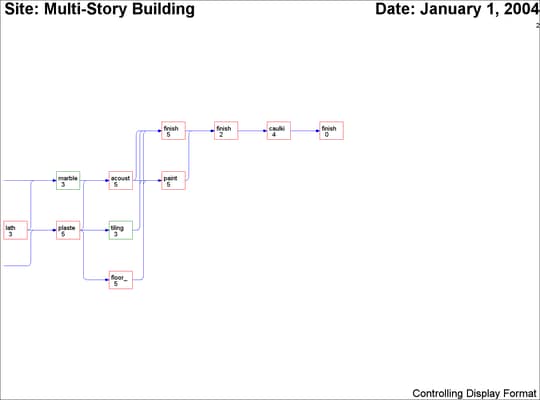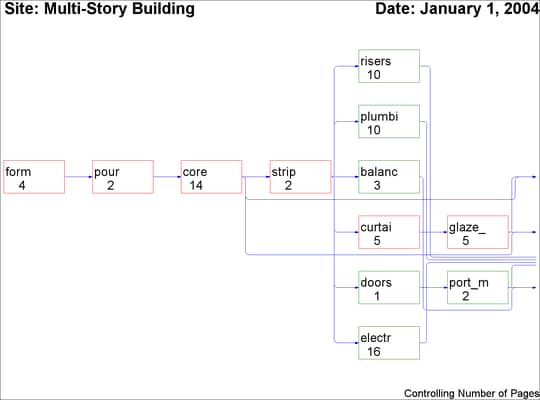The NETDRAW Procedure
- Overview
- Getting Started
-
Syntax

-
Details
 Network Input Data SetVariables in the Network Data SetMissing ValuesLayout of the NetworkFormat of the DisplayPage FormatLayout Data SetControlling the LayoutTime-Scaled Network DiagramsZoned Network DiagramsOrganizational Charts or Tree DiagramsFull-Screen VersionGraphics VersionUsing the Annotate FacilityWeb-Enabled Network DiagramsMacro Variable _ORNETDRComputer Resource RequirementsODS Style Templates
Network Input Data SetVariables in the Network Data SetMissing ValuesLayout of the NetworkFormat of the DisplayPage FormatLayout Data SetControlling the LayoutTime-Scaled Network DiagramsZoned Network DiagramsOrganizational Charts or Tree DiagramsFull-Screen VersionGraphics VersionUsing the Annotate FacilityWeb-Enabled Network DiagramsMacro Variable _ORNETDRComputer Resource RequirementsODS Style Templates -
Examples
 Line-Printer Network DiagramGraphics Version of PROC NETDRAWSpanning Multiple PagesThe COMPRESS and PCOMPRESS OptionsControlling the Display FormatNonstandard Precedence RelationshipsControlling the Arc-Routing AlgorithmPATTERN and SHOWSTATUS OptionsTime-Scaled Network DiagramFurther Time-Scale OptionsZoned Network DiagramSchematic DiagramsModifying Network LayoutSpecifying Node PositionsOrganizational Charts with PROC NETDRAWAnnotate Facility with PROC NETDRAWAOA Network Using the Annotate FacilityBranch and Bound TreesStatement and Option Cross-Reference Tables
Line-Printer Network DiagramGraphics Version of PROC NETDRAWSpanning Multiple PagesThe COMPRESS and PCOMPRESS OptionsControlling the Display FormatNonstandard Precedence RelationshipsControlling the Arc-Routing AlgorithmPATTERN and SHOWSTATUS OptionsTime-Scaled Network DiagramFurther Time-Scale OptionsZoned Network DiagramSchematic DiagramsModifying Network LayoutSpecifying Node PositionsOrganizational Charts with PROC NETDRAWAnnotate Facility with PROC NETDRAWAOA Network Using the Annotate FacilityBranch and Bound TreesStatement and Option Cross-Reference Tables - References
Example 9.5 Controlling the Display Format
In addition to the COMPRESS and PCOMPRESS options and the HPOS= and VPOS= global options, you can control the amount of information displayed on a single page by
-
turning off the default ID variable selection (using the NODEFID option) and using the ID= option to select only a few variables of interest in the Network data set
-
setting the dimensions of each node using the BOXWIDTH= and the BOXHT= options
-
specifying the horizontal and vertical distances between nodes using the XBETWEEN= and YBETWEEN= options, respectively
This example uses the data from Example 8.1 in Chapter 8: The GANTT Procedure, and some of the options just mentioned to produce the network diagram shown in Output 9.5.1. The ID= and NODEFID options are used to display only the activity name and duration values within each node. The NOLABEL option suppresses the display of the variable names within each node. Some of the activity names are truncated by the BOXWIDTH= option. Even with the restrictions imposed, the network is too large to fit on one page and spans two pages. Note that on devices with higher resolution, you can increase the values of HPOS and VPOS (still maintaining readability) to enable more of the network to be drawn on one page.
data ex;
format activity $20. success1 $20. success2 $20. success3 $20.
success4 $20.;
input activity dur success1-success4;
datalines;
form 4 pour . . .
pour 2 core . . .
core 14 strip spray_fireproof insulate_walls .
strip 2 plumbing curtain_wall risers doors
strip 2 electrical_walls balance_elevator . .
curtain_wall 5 glaze_sash . . .
glaze_sash 5 spray_fireproof insulate_walls . .
spray_fireproof 5 ceil_ducts_fixture . . .
ceil_ducts_fixture 5 test . . .
plumbing 10 test . . .
test 3 insulate_mechanical . . .
insulate_mechanical 3 lath . . .
insulate_walls 5 lath . . .
risers 10 ceil_ducts_fixture . . .
doors 1 port_masonry . . .
port_masonry 2 lath finish_masonry . .
electrical_walls 16 lath . . .
balance_elevator 3 finish_masonry . . .
finish_masonry 3 plaster marble_work . .
lath 3 plaster marble_work . .
plaster 5 floor_finish tiling acoustic_tiles .
marble_work 3 acoustic_tiles . . .
acoustic_tiles 5 paint finish_mechanical . .
tiling 3 paint finish_mechanical . .
floor_finish 5 paint finish_mechanical . .
paint 5 finish_paint . . .
finish_mechanical 5 finish_paint . . .
finish_paint 2 caulking_cleanup . . .
caulking_cleanup 4 finished . . .
finished 0 . . . .
;
proc cpm finishbefore date='1jan04'd out=sched; activity activity; duration dur; successors success1-success4; run; proc sort; by e_start; run;
goptions hpos=147 vpos=75 border;
pattern1 v=e c=green;
pattern2 v=e c=red;
title j=l h=3 ' Site: Multi-Story Building'
j=r ' Date: January 1, 2004';
footnote j=r h=2 'Controlling Display Format ';
proc netdraw data=sched graphics;
actnet / act = activity
succ = (success1-success4)
id = ( activity dur )
nolabel nodefaultid
boxwidth = 6
ybetween = 6
separatearcs;
run;
Output 9.5.1: Controlling the Display Format


You can also control the format of the display by specifying the number of pages into which the network diagram should be split. You can do this by
-
using the HPAGES= and VPAGES= options, which specify the number of pages in the horizontal and vertical directions, respectively
-
setting the number of nodes in the horizontal and vertical directions using the NXNODES= and NYNODES= options, respectively
The following statements invoke PROC NETDRAW with some additional page control options. The HTEXT= option is also used to control the height of the text used in the diagram.
footnote j=r h=2 'Controlling Number of Pages';
proc netdraw data=sched graphics;
actnet / act = activity
succ = (success1-success4)
id = ( activity dur )
nolabel nodefaultid
boxwidth = 6
ybetween = 6
separatearcs
htext=2
nopagenumber
hpages=3 vpages=1;
run;
Output 9.5.2: Controlling the Number of Pages


